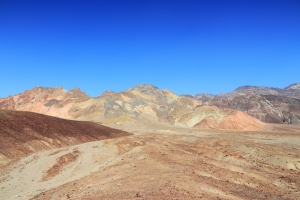
Examples of Alluvial Fan Landforms:
Death Valley National Park, California, USA
Near the mountains south of the Taklamakan Desert in Xinjiang, China lies an alluvial fan 25 miles long and nearly as wide. The best example of an alluvial fan is the one in Nepal created by the streaming Koshi River. It has an area of almost 15000 square kilometers.
An alluvial fan is a fan-shaped or triangular pattern of sand, gravel or other sediment that is spread by water over an area of the ground, hillside or mountain.
An alluvial fan is formed by running water like rivers and streams that carries sand, gravel or other sediment over the ground, hillside or mountain. It begins from a single point and is spread by the movement of water that flows over the area. If an alluvial fan happens on a steep mountainside, it can be very narrow. Over flat areas of land, the fan shape can be very wide.
An alluvial fan may be found in the desert where flooding has occurred. Occasional heavy rainfall causes water to rush over some areas of the desert, creating patterns on the ground. Alluvial fans also occur on hillsides and mountainsides where water escapes from a single point as water from rainfall flows downward. They sometimes occur when rivers rise during periods of heavy rainfall. Water can escape the river at one point, flowing outward over the land to create a fan shaped pattern. They can even be found underwater, created by currents that move sediment over the sea floor.
An alluvial fan can be as small as a few inches, or it can be many miles wide. A portion of the Koshi river in Nepal has created an alluvial fan that covers almost 6000 square miles of land.
The apex is the narrower part of the alluvial fan and the apron is the wide triangle. The apron of an alluvial fan can have length of just a few centimeters dispersing out from the drops of water out of a drainpipe. This means that alluvial fans can really be small. On the other hand, there are alluvial fans that can show great lengths and widths.
Areas where alluvial fans occur can be flooded again and again when there is heavy rainfall. Building a home on an alluvial fan is not a good idea.
A fan shaped or triangular pattern of sand, gravel or other sediment that is spread by water over an area of the ground, hillside or mountain
We want pictures and location of the lanforms around the world and we need your help. Click get started button below.
In Asia, China, India, Nepal, and Bhutan are home to one of the eight wonders of the world and one of the most beautiful mountains in the world, the Himalaya Mountains also called the Himalayas. Boasting as the world’s highest and most famous mountain peak, Mt. Everest. Within the verse of the ‘Kumarsambhava’, Sanskrit […]
Nature have provided us with fascinating landforms and features. The most often adored landforms are volcanoes. Like the perfect cone structure of Mayon Volcano in the Philippines or Mount Fiji in Japan, people look at their beauty and wonder with great appreciation to nature. Volcanoes are mountains with a very disastrous nature. Their only […]
Taal Volcano is the second most active volcano found in the province of Batangas. A complex volcano in the middle of Taal Lake and is often called an island within a lake, that is an island within a lake that is on an island as well as one of the lowest volcano in the […]
Mayon Volcano is one of the active volcanoes in the Philippines. Located in the southern part of Luzon about 473 kilometers (294 miles) from Makati Business District of the Philippines, Mount Mayon is the main landmark of the Province of Albay of Bicol Region. According to local folklore, the volcano was named after Daragang […]
The global temperature and weather is to a large extent a direct result of the sun’s effect to our planet. Together with the atmosphere and the rotation of the earth on its axis. The earth on which weather moves on has its own effect on the weather. The different landforms like mountains, volcanoes, plains, and the […]